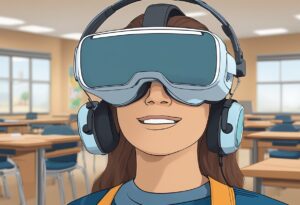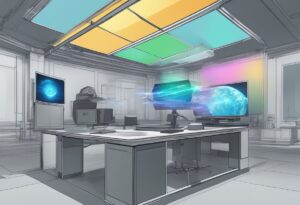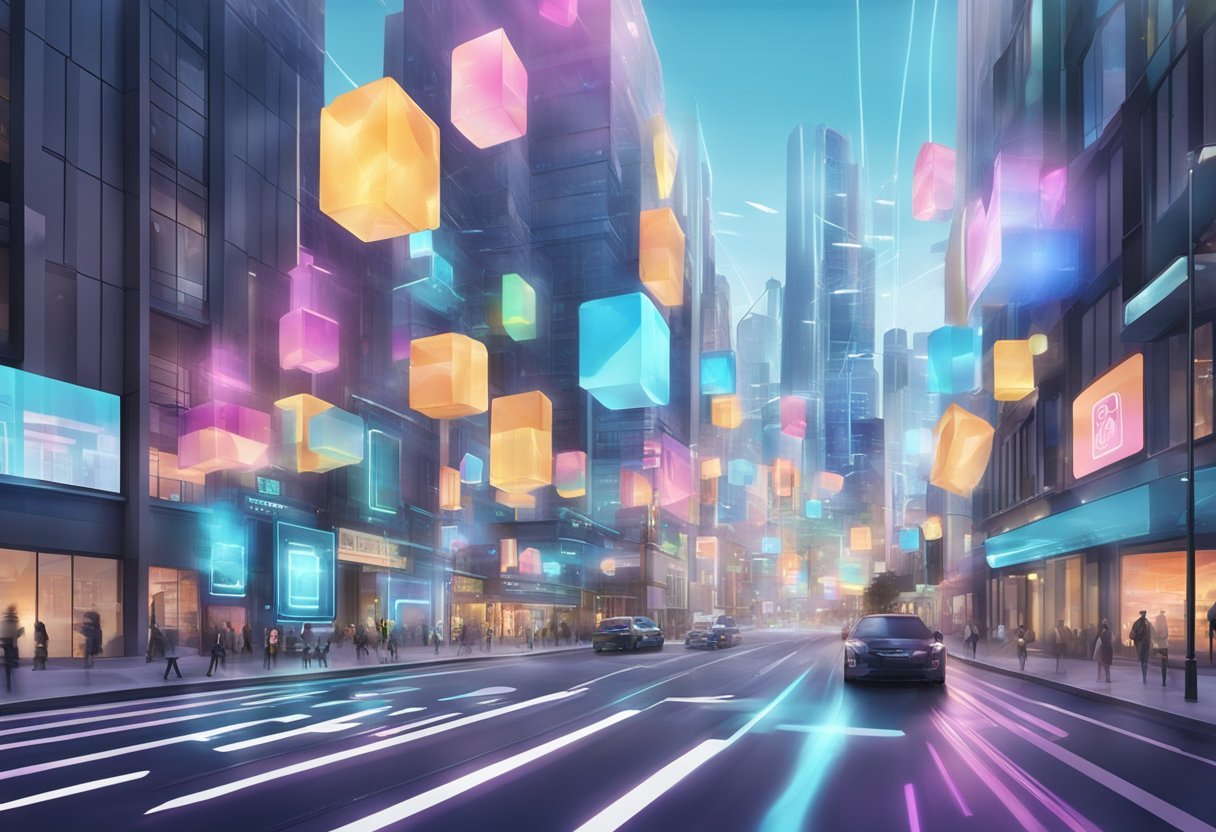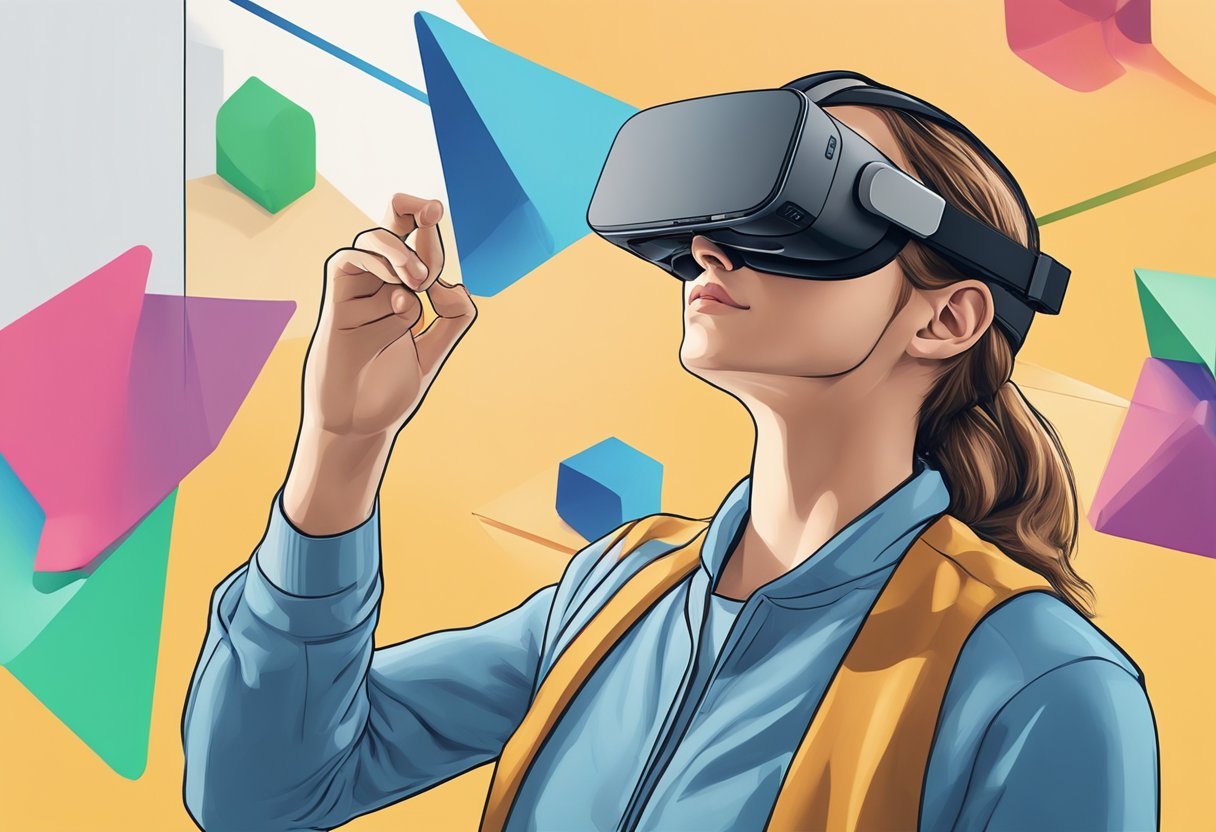Augmented reality (AR) is a technology that has been around for a while, but it has only recently gained mainstream attention. AR is a technology that enhances the real world by adding digital elements such as sound, video, and graphics. It is a powerful tool that has many applications in various industries, including healthcare, education, and entertainment.
AR is different from virtual reality (VR) in that it does not create a completely new environment. Instead, it overlays digital elements onto the real world, creating a more immersive experience. AR is already being used in many ways, such as in mobile apps, where users can point their phone’s camera at an object and see information about it displayed on the screen. AR is being used in the gaming industry to create more interactive and immersive experiences for players.
Foundations of Augmented Reality
Defining AR and Its Core Elements
Augmented Reality (AR) is a technology that overlays digital elements onto the real-world environment, creating a composite view of physical and digital elements. AR systems incorporate three basic features: a combination of real and virtual worlds, real-time interaction, and accurate 3D registration of virtual and real objects.
AR technology has evolved rapidly in recent years, with the development of more advanced computer vision and machine learning algorithms. AR devices can now recognize and track physical objects in real time, allowing for more accurate and seamless integration of digital elements into the real world.
Comparing AR, VR, and Mixed Reality
AR is often compared to Virtual Reality (VR) and Mixed Reality (MR). While AR overlays digital elements onto the real world, VR creates a completely immersive digital environment, while MR blends digital elements with the real world.
AR is particularly useful in applications where users need to interact with both the real and digital worlds simultaneously, such as in industrial settings or in gaming.
VR is more suited to applications where users need to be completely immersed in a digital environment, such as in training simulations or entertainment. MR is a hybrid of AR and VR, and is useful in applications where users need to interact with digital elements in the real world, such as in architecture or engineering.
Augmented reality elements
Here are the 15 elements of AR:
- Real-world Environment: Augmented reality (AR) integrates digital information and virtual objects into the real-world environment.
- Hardware Devices: AR relies on various hardware devices, including smartphones, tablets, smart glasses, and headsets, to deliver augmented experiences.
- Sensors: Devices equipped with sensors, such as cameras, GPS, accelerometers, and gyroscopes, capture real-world data and enable the system to understand and interact with the environment.
- Computer Vision: Computer vision technology processes visual information from the real world, allowing AR systems to recognize and track objects, surfaces, and movements.
- Marker or Image Recognition: AR applications often use markers or image recognition to trigger the display of virtual content when the device identifies specific images or patterns.
- Display: AR overlays digital content onto the physical world through the device’s display, providing users with a blended view of reality and virtual elements.
- Processing Power: AR requires significant processing power to render and display virtual content in real-time, ensuring a seamless integration with the real-world environment.
- Software Applications: AR applications and software platforms enable the creation, development, and deployment of augmented reality experiences for various purposes, from gaming to education and industry.
- Cloud Computing: Cloud-based services support AR by providing additional processing capabilities, storage, and content delivery, reducing the burden on individual devices.
- Networking: Augmented reality systems may rely on network connectivity to access real-time information, updates, and collaborative experiences.
- Interaction Methods: AR interfaces often involve gesture recognition, voice commands, or touch interactions, allowing users to engage with and manipulate virtual objects in the augmented environment.
- 3D Models and Content: Augmented reality experiences incorporate 3D models, animations, and digital content to enhance the user’s perception of the real-world surroundings.
- Augmented Reality SDKs: Software Development Kits (SDKs) provide tools and resources for developers to create AR applications, ensuring compatibility with specific devices and platforms.
- Geolocation Services: AR applications can use geolocation services to integrate location-based information, enriching the user experience with contextually relevant data.
- Augmented Reality Markup Language (ARML): ARML is a standardized language that allows developers to describe and present AR content consistently across various devices and platforms.
Technological Components
Hardware Essentials for AR
The hardware components of an AR system include a display, camera, sensors, and interaction devices. The display system is a crucial element of AR technology, and it can be in the form of a headset, smartphone, or tablet. The camera captures the real-world environment and sends it to the AR software for processing. The interaction devices, such as hand-held controllers or touchpads, allow users to manipulate the AR objects.
Software Frameworks and AR Software
AR software is the backbone of an AR system, and it is responsible for processing the real-world environment and overlaying virtual objects. AR software uses computer vision technology to recognize and track the user’s environment, and it requires powerful processors to deliver a seamless AR experience.
Software frameworks, such as ARKit and ARCore, provide developers with the tools to create AR applications for different platforms. These frameworks offer features like motion tracking, scene understanding, and light estimation, making it easier for developers to create AR applications.
AR in Different Industries

Augmented Reality (AR) has found its way into different industries, providing a new level of interaction and engagement. AR technology can enhance the user experience, streamline processes, and improve decision-making. Here are some examples of how AR is being used in different industries.
Retail and E-Commerce Applications
AR is revolutionizing the retail and e-commerce industry. It allows customers to try on clothes virtually, visualize furniture in their homes, and even see how makeup looks on their faces.
AR technology has the potential to increase sales and customer satisfaction by providing an immersive and personalized experience. AR can help retailers reduce returns and improve inventory management.
Manufacturing and Maintenance
AR has significant applications in industrial manufacturing and maintenance. It can help workers visualize and use data in real-time, enabling them to make timely data-driven decisions.
AR also promotes virtues like cross-team collaboration, paperless workforce, and simplified manufacturing workflows. AR can also be used to provide maintenance technicians with real-time information on equipment, reducing downtime and increasing efficiency.

Healthcare and Medical Training
AR is also being used in healthcare and medical training. It can help medical students understand complex anatomy and procedures, simulate surgeries, and provide real-time feedback. AR can also be used to train healthcare professionals on new medical devices and equipment.
In addition, AR can be used to provide patients with an immersive and interactive experience, reducing anxiety and improving outcomes.
AR technology has the potential to transform different industries, providing a new level of engagement and interaction. As the technology continues to evolve, we can expect to see more innovative applications of AR in the future.
User Experience and Interaction In AR
Designing for AR
User Experience (UX) is an essential factor in designing augmented reality (AR) elements. UX designers must consider the physical world and digital visual elements when designing for AR. They must ensure that the AR elements are intuitive, easy to use, and enhance the user’s experience.
In AR, users interact with digital content overlaid on the physical world. The digital content must be designed to blend seamlessly with the physical world to create a natural and immersive experience. UX designers must consider the user’s context, environment, and the physical world when designing AR elements.
Physical and Digital Interaction
AR allows users to interact with digital content in real-time, creating a unique and engaging experience. Physical and digital interaction is a crucial aspect of designing AR elements.
Physical interaction involves the user’s movements and actions in the physical world. Digital interaction involves the user’s interactions with digital content overlaid on the physical world. UX designers must ensure that the physical and digital interactions are seamless and intuitive, creating a natural and immersive experience.
AR allows for enhanced interaction between users and digital content. For instance, users of a retail app can utilize AR to visually try on clothing, allowing them to see how the items might fit them without having to visit an actual store. UX designers must design AR elements that enhance the user’s experience and create a unique and engaging interaction.
Designing for AR requires a deep understanding of the user’s context, environment, and the physical world. UX designers must ensure that AR elements are intuitive, easy to use, and enhance the user’s experience.
AR in Education and Training

Augmented Reality (AR) is a technology that overlays digital information on top of the real-world environment. AR provides a unique opportunity for interactive learning environments that enhance the learning experience. AR can be used in education and training to create immersive and engaging experiences that make learning more effective.
Interactive Learning Environments
AR enables the creation of interactive learning environments that engage students in real-time. AR can be used to enhance textbooks by providing students with additional information, videos, and images.
AR can also be used to create virtual field trips that allow students to explore locations that would otherwise be inaccessible. This allows students to learn about different cultures, places, and historical events in an interactive and engaging way.
Simulation and Training Tools
AR can be used to create simulation and training tools that provide a safe and cost-effective way to train individuals in various fields. AR can be used in medical training to create realistic scenarios that allow medical professionals to practice procedures and techniques in a safe and controlled environment.
AR can also be used in engineering and manufacturing to train workers on complex machinery and equipment.
AR has the potential to revolutionize education and training by providing immersive and engaging experiences that make learning more effective. As AR technology continues to evolve, it is likely that we will see more and more applications of AR in education and training.
Gaming and Entertainment
Augmented reality has revolutionized gaming and entertainment industries by providing a new level of immersive experience. AR games development has become increasingly popular, with the most famous being Pokémon Go, which attracted millions of users worldwide.
AR games development brings game elements to the real world, allowing players to interact with virtual objects in the physical environment. This technology has enhanced accessibility, as it can be experienced using everyday devices like smartphones and tablets.
AR Games Development
AR games development has opened up new possibilities for game developers, allowing them to create engaging and interactive games that blur the line between the real and virtual world.
AR games detect the real world and overlay game visuals and audio using sensors such as cameras, microphones, and GPS. This technology has provided a new level of engagement and entertainment, motivating people to exercise by incorporating game elements into their daily activities.
AR in Movies and Live Events
AR has also found its way into movies and live events, creating a new level of immersion and interactivity. AR in movies allows filmmakers to blend the real and virtual world, adding new layers of storytelling and visual effects.
AR in live events provides a new level of engagement, allowing audiences to interact with virtual objects and characters in real-time. This technology has provided a new level of entertainment, allowing people to experience movies and live events in a whole new way.
In conclusion, AR has revolutionized gaming and entertainment industries, providing a new level of immersive experience. AR games development has opened up new possibilities, allowing game developers to create engaging and interactive games.
AR in movies and live events has also provided a new level of immersion and interactivity, allowing audiences to experience movies and live events in a whole new way.
Optics and Imaging in AR

Augmented Reality (AR) technology involves the use of optical systems to superimpose digital information onto the real world. The quality and accuracy of the optical system is critical to the success of AR applications.
This section will discuss the role of optics and imaging in AR, with a focus on lenses and field of view, as well as holography and holographic elements.
Lenses and Field of View
Lenses are a crucial component in AR optical systems. They are used to correct aberrations and achieve the desired field of view (FOV). FOV is the angular extent of the environment that can be seen by the user.
A larger FOV allows for a more immersive experience, but it also requires a more complex optical system. Diffractive waveguides are a type of lens that can be used to achieve a larger FOV without increasing the size of the optical system.
Holography and Holographic Elements
Holography is a technique that uses interference patterns to create three-dimensional images. Holographic optical elements (HOEs) are a type of diffractive element that can be used in AR systems.
HOEs can replace traditional lenses and mirrors, and they can be used to correct aberrations, increase FOV, and provide eye relief. HOEs can also be used to create compact and lightweight AR displays.
In conclusion, the success of AR applications depends on the quality and accuracy of the optical system. Lenses and FOV are critical components of AR optical systems, and diffractive waveguides can be used to achieve a larger FOV.
Holography and HOEs are emerging technologies that can provide significant benefits to AR systems, including increased FOV, eye relief, and compactness.
AR Device Form Factors

Head-Mounted and Eyewear Solutions
Head-mounted displays (HMDs) and smart glasses are two popular types of AR device form factors. HMDs are worn on the head and typically come with a visor or screen that covers the user’s eyes, while smart glasses are similar to regular eyeglasses and have a small display in the corner of the user’s field of vision.
HMDs are often used for immersive experiences, such as gaming or training simulations, while smart glasses are designed for more practical applications, such as hands-free navigation or remote assistance. Some popular examples of HMDs include the Oculus Rift and the HTC Vive, while popular smart glasses include the Google Glass and Microsoft HoloLens.
Handheld AR Devices
Handheld AR devices, such as smartphones and tablets, are another popular form factor for AR. These devices use the device’s camera and display to overlay digital information onto the real world. Handheld AR devices are widely available and generally more affordable than HMDs or smart glasses.
Smartphones and tablets are especially popular for AR gaming and social media applications, such as Pokemon Go and Snapchat filters. However, their smaller screens and less immersive experience make them less suitable for certain types of AR applications, such as training simulations or remote assistance.
AR device form factors vary widely in terms of design, functionality, and intended use. Choosing the right form factor depends on the specific application and user needs.
Challenges and Future of AR
Overcoming Technical Limitations
Augmented Reality (AR) is a fast-growing technology that has the potential to revolutionize the way we interact with the world. However, there are still technical limitations that need to be overcome for AR to reach its full potential. One of the major challenges is ergonomics.
AR devices need to be comfortable and lightweight to wear for extended periods. The physical constraints of AR devices, such as battery life and processing power, also need to be addressed to improve the user experience.
Another challenge is dynamic range. AR devices need to be able to adapt to various lighting conditions to provide a seamless experience.
This requires advanced sensors and algorithms that can detect and adjust to changes in lighting quickly. To achieve this, AR devices need to have a large dynamic range to capture a wide range of lighting conditions.
AR and the Metaverse
AR has the potential to play a significant role in the development of the Metaverse, a virtual world where users can interact with each other and digital objects in real-time.
AR can be used to create immersive experiences that blur the line between the physical and digital worlds. However, to achieve this, AR devices need to be able to handle big data and process it in real-time. This requires advanced computing power and efficient algorithms.
AR also needs to be able to seamlessly integrate with other technologies, such as virtual reality (VR) and artificial intelligence (AI), to create a truly immersive experience. This requires a high level of interoperability between different technologies and standards.
AR has the potential to change the way we interact with the world. However, to achieve this, technical limitations need to be overcome, and AR needs to seamlessly integrate with other technologies. With continued research and development, AR has a bright future ahead.
Materials and Fabrication Techniques
Innovations in Holographic Materials
In the last decade, there has been a significant increase in the development of materials for use in holographic optical elements (HOEs). Holographic polymer-dispersed liquid crystal (HPDLC) is one such material that has been extensively studied for use in HOEs.
HPDLCs have been found to have excellent optical properties and can be used in a variety of applications, including displays, sensors, and optical filters.
Liquid crystal (LC) materials have also been used in HOEs to achieve high diffraction efficiency and polarization selectivity. Dichromated gelatin (DCG) is another material that has been used in HOEs due to its high diffraction efficiency and low scattering.
Advances in Fabrication Processes
Innovations in fabrication processes have also contributed to the development of more advanced HOEs. One such process is the use of monomers to create HOEs. This process involves the use of a photo-initiated polymerization reaction to create a hologram. The resulting HOE has excellent optical properties and can be used in a variety of applications.
Another fabrication technique that has been developed is the use of nanoimprint lithography to create HOEs. This technique involves the use of a mold to create a pattern on a substrate. The resulting HOE has high diffraction efficiency and can be used in a variety of applications.
Overall, the development of new materials and fabrication techniques has led to the creation of more advanced HOEs. These HOEs have a variety of applications, including displays, sensors, and optical filters.
The use of HPDLCs, LC materials, DCG, monomers, and nanoimprint lithography has resulted in HOEs with excellent optical properties and high diffraction efficiency. These innovations will continue to drive the development of new HOEs and expand their use in a variety of applications.

Frequently Asked Questions
What are the primary applications of augmented reality in various industries?
Augmented Reality (AR) has numerous applications in various industries, including healthcare, education, entertainment, retail, and advertising. In healthcare, AR technology is used for surgical procedures, training, and diagnosis.
In education, AR is used to create interactive learning experiences. In the entertainment industry, AR is used to create immersive gaming experiences. AR is also used for product visualization in retail and advertising.
How is augmented reality transforming educational experiences?
AR is transforming educational experiences by creating interactive and engaging learning environments. AR technology enables students to visualize complex concepts and interact with them in real-time, making learning more fun and effective. AR is also used to create virtual field trips, allowing students to explore different places and cultures without leaving the classroom.
What are the differences between augmented reality and mixed reality?
Augmented Reality (AR) and Mixed Reality (MR) are two related but distinct technologies. AR overlays virtual objects onto the real world, while MR blends virtual and real-world elements seamlessly. MR is more immersive than AR and requires more advanced hardware and software.
What types of devices are commonly used for experiencing augmented reality?
There are numerous devices that can be used to experience augmented reality, including smartphones, tablets, smart glasses, and head-mounted displays. Smartphones and tablets are the most common devices used for AR, while smart glasses and head-mounted displays are used for more immersive experiences.
How does augmented reality technology integrate with the real world?
AR technology integrates with the real world by overlaying virtual objects onto the real world. AR uses computer vision and other technologies to track real-world objects and create a seamless integration between the virtual and real worlds.
What are the fundamental components that constitute an augmented reality system?
The fundamental components of an augmented reality system include a display device, a camera, and a computer. The display device is used to display virtual objects, while the camera captures the real-world environment. The computer processes the data from the camera and generates the virtual objects.
What are the key concepts of augmented reality?
The key concepts of augmented reality include registration, tracking, and rendering. Registration refers to the process of aligning virtual objects with the real world.
Tracking refers to the process of tracking the real-world environment and the user’s movements. Rendering refers to the process of generating the virtual objects and displaying them on the display device.
What are the 3 types of augmented reality?
There are three types of augmented reality: marker-based AR, markerless AR, and projection-based AR. Marker-based AR uses markers or images to trigger virtual objects, while markerless AR uses computer vision to detect real-world objects. Projection-based AR projects virtual objects onto real-world surfaces.
What is the structure of augmented reality?
The structure of augmented reality includes the real-world environment, the virtual objects, and the user. The real-world environment is captured by a camera, while the virtual objects are generated by a computer. The user interacts with the virtual objects through a display device.
What are the basics of augmented reality?
The basics of augmented reality include overlaying virtual objects onto the real world, tracking the real-world environment, and rendering the virtual objects. AR technology uses computer vision and other technologies to create a seamless integration between the virtual and real worlds.
What are the common features of augmented reality?
The common features of augmented reality include interactivity, immersion, and real-time processing. AR technology enables users to interact with virtual objects in real-time, creating an immersive experience.
What are the four different types of augmented reality?
There are four different types of augmented reality: marker-based AR, markerless AR, projection-based AR, and superimposition-based AR. Superimposition-based AR overlays virtual objects onto the real world without requiring any tracking or registration.
What are the five features for modeling augmented reality?
The five features for modeling augmented reality include object recognition, object tracking, camera calibration, lighting, and occlusion. Object recognition refers to the process of identifying real-world objects, while object tracking refers to the process of tracking the user’s movements.
Camera calibration is used to ensure accurate tracking and rendering, while lighting is used to create a realistic and immersive experience. Occlusion refers to the ability of virtual objects to interact with real-world objects.
What is the difference between AR and VR?
The main difference between AR and VR is that AR overlays virtual objects onto the real world, while VR creates a completely virtual environment. VR requires more advanced hardware and software than AR and is used for immersive gaming and simulation experiences. AR is used for a wide range of applications, including education, healthcare, and advertising.




